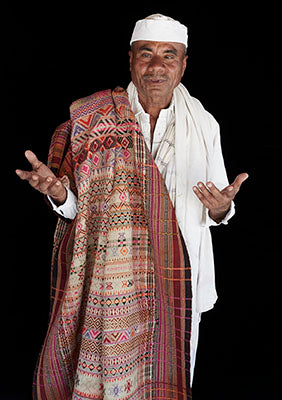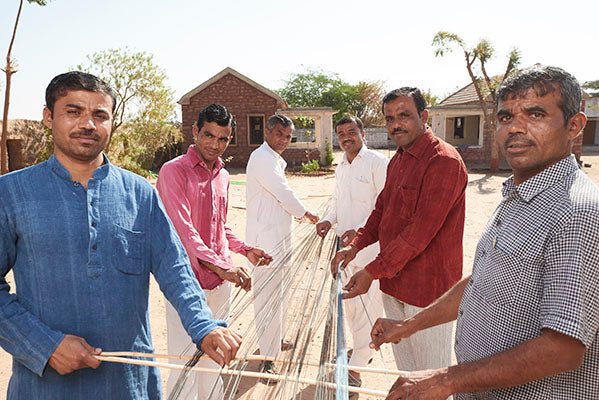
See The Bhujodi Shawls & Scarves
The Kachchh Desert is home to an astonishing variety of artisanal production. Of the weaving traditions which flourish near the town of Bhuj, the collaboration between Rabari and Vankar communities is perhaps the best known. The Rabari are pastoralist herders who are also spinners and embroiderers. The Vankar community are accomplished weavers. For generations the two communities have been working together to make the traditional shawls worn by Rabari men and women. Some styles of shawl are also patterned with bandhani resist (tie-and-die) and for this they are passed to a third group of artisans; the Khatris, who are dyers.
In 1974 Shri Vishram Valji Vankar won India's prestigious National Award for weaving (pictured below with his masterwork). The recognition garnered by the award strengthened his conviction that his six sons should follow the family craft of weaving.


Maiwa has been working with the sons and especially Master Weaver Shamji Vankar (pictured below at the loom) for many years. Their work was featured in our weaving documentary: Tana Bana: Wisdom of the Loom (released in 2005). In 2011, Shamji Vankar participated in the Maiwa Masterclass held in Bengal. It was in response to the vital exchange of natural dye knowledge that the Vankar family pushed for natural dye use. Today the family have gone beyond their traditional colours and have expanded to a entirely new range of natural colours which they dye themselves.


The group have also moved beyond the Deshi (country) wool from the local sheep to work with wild silks like tussar, eri, and muga. More importantly they have been working with multiple fibres; combinations of wools, silks and cottons to achieve weaves that work well on traditional looms and showcase natural colour. The spinners and weavers are also able to work with India's kala cotton, an indigenous variety that has evolved under desert conditions and does not require excessive irrigation or pesticides to flourish in Kachchh.


Contemporary work produced by the Vankars is in a class of its own. The success of the Vankar family confirms for us the idea that skill is the most effective trade protection for artisans. The naturally dyed hand-weaves that the Vankars produce are very difficult to copy. Those who purchase this high-quality work are directly responsible for the advancement of the Vankar’s weaving and dyeing skills to a level that is now unsurpassed on the world stage.
Below is a masterpiece woven in silk and wool. The patron who commissioned the piece did so through Maiwa, requesting a work that would reflect the highest skill-level the family could produce. This final cloth was then gifted to the Maiwa Collection so that it could be shown to the public. It stands apart as an example of the best of Bhujodi weaving and dyeing. In 2019 Shamji Vankar was invited to present at the Maiwa School of Textiles and his masterwork (pictured below) was featured on the cover of the Maiwa School of Textiles Course Calendar.
